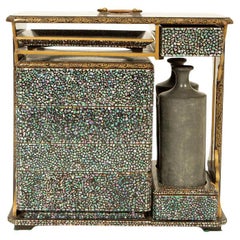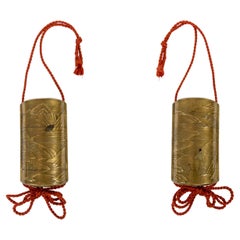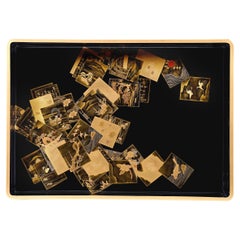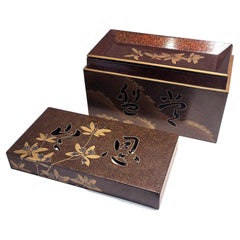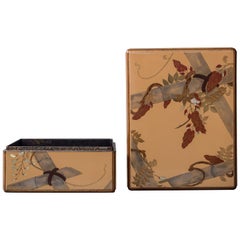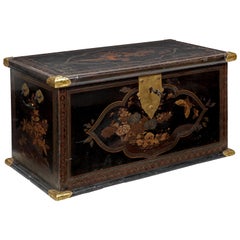Lacquer
to
49
381
152
594
5
3
9
5
3
2
2
1
1
87
312
195
8
104
51
14
11
1
13
7
1
4
4
3
1
454
253
117
48
34
557
487
285
197
43
602
598
602
3
1
1
1
1
Lacquer For Sale
Antique 20th Century Japanese Mother-of-Pearl Bento Box
Located in LOS ANGELES, CA
Beautiful and antique Japanese Mother-of-Pearl Bento Box with full array of components included. Unique iridescent lacquer finish throughout, with black & gold hand painted details a...
Category
20th Century Japanese Other Lacquer
Materials
Mother-of-Pearl
Japanese Sagemono Inro box with a maki-e decor of a Samuari in a lake landscape
Located in PARIS, FR
Inrô in gilded lacquer according to the takamaki-e, hiramaki-e and kirigane techniques, with five squares of a mountain lake landscape.
On the first side, there is a man on horsebac...
Category
18th Century Japanese Edo Antique Lacquer
Materials
Gold
Japanese Lacquer Tray With Cards
Located in New Orleans, LA
This Meiji-period lacquer tray represents the mastery of Japanese craftsmen in the art of lacquer work. Precious materials are precisely inlaid in the lacquer base, creating a highly...
Category
Late 19th Century Japanese Meiji Antique Lacquer
Materials
Gold
Japanese Maki-e Lacquer Tray Box with Cutout Design
Located in Atlanta, GA
A Japanese lacquer box with lid and an inner tray decorated with Maki-e on a dense nashiji background. The fine box was likely made circa 1920-30s...
Category
1920s Japanese Taisho Vintage Lacquer
Materials
Wood, Lacquer
Japanese Lacquer Letter Box with Flowers and Butterfly
Located in Hudson, NY
With silver rim, and interior decoration of falling petals and gold dust. Comes with original storage box.
Category
Early 20th Century Japanese Meiji Lacquer
Materials
Lacquer
Large Royal Early 17th Century Japanese Lacquer Chest with Gilt-Bronze Mounts
Located in Amsterdam, NL
A large Japanese transitional lacquer chest with gilt-metal mounts
Edo period, early 17th century
The rectangular chest with flat hinged lid decorated in gold, silver, and red ...
Category
Early 17th Century Japanese Antique Lacquer
Materials
Bronze
Japanese Lacquered Furoshiki Kobako 'Box'
Located in PARIS, FR
Rectangular and flat lacquer Kobako (small box) representing a furoshiki knot seen from above. Fundame background, furoshiki in takamaki-e with floral pattern, inside the folds of the fabric with black and gold sayagata pattern with togidashi maki-e technique. The saya (or sayagata) pattern is composed of Chinese swastikas...
Category
Late 19th Century Japanese Antique Lacquer
Materials
Lacquer
Lacquered Worker Bowl Kanshitsu Bachi, Showa Period, 20th Century
Located in Fukuoka, JP
This beautiful lacquer worker bowl, known as “Kanshitsu Bachi,” hails from the Showa period of the 20th century. Crafted with a deep, rich pattern that...
Category
20th Century Japanese Lacquer
Materials
Wood, Lacquer
A Very Fine Takamaki-e Lacquer Cheroot Case in the Manner of Shibata Zeshin
By Shibata Zeshin
Located in Ottawa, Ontario
The 'ishime' lacquered case consisting of two conforming molded sections with one sliding overtop the other, both sides decorated with hand painted gilt, silver & burnt dark russet (kasshoku) lacquers, depicting motifs in low relief of a rat with an acorn on one side and two acorns on the opposing.
In Japanese culture rats are considered auspicious symbols of fertility & wealth, acorns symbolize prosperity & growth. Signed with characters and a mon on one edge.
Takamaki-e is a lacquer technique in which metallic powders such as silver, gold, copper, pewter etc., are used in combination with lacquer & clay-dust to build up motifs in low relief.
Please note that the color tones & hues of the lacquered motifs appear somewhat more vibrant in the images due to ambient lighting conditions.
Regarding the opinion stating the superior quality of this fine example being likened to works associated with those by Shibata...
Category
1870s Japanese Meiji Antique Lacquer
Materials
Lacquer
Red and Gold Lacquer Portable Tea Bucket and Cover Ryukyu Kingdom Okinawa
Located in Atlanta, GA
A rare and complete set of wood bucket with cinnabar lacquer and gold paint housing a pewter tea pot with a fabric pouch from Ryukyu Kingdom, Second Shō dynasty, circa 19th century. Located in nowadays Okinawa Prefecture, Japan. Ryukyu kingdom (1429 to 1879) was a tributary state of imperial Ming...
Category
19th Century Japanese Edo Antique Lacquer
Materials
Pewter
Early 19th Century Long Chinese Export Black Lacquer Box with a Walking Stick
Located in Brea, CA
Early 19th century Chinese export lacquer and gilt box with a walking stick from the Qing dynasty, bone walking stick in black lacquered wood box, w...
Category
Mid-19th Century Chinese Qing Antique Lacquer
Materials
Lacquer
Fine Japanese Black and Gold Lacquer Sageju-Bako - Picnic Box
Located in PARIS, FR
Black and gold lacquer sageju-bako (picnic box) decorated with floral motifs in hiramaki-e. It includes a sake bottle, a four-compartment box with nashi-ji lacquer inside, a simple tray and a hollow tray. At the top, there is a bronze handle for transport.
The sageju-bako is divided into four superimposed boxes for food on the left; a simple tray, a sake bottle and a hollow tray on the right. They are in the shape of a plum blossom.
On the top, on both sides a phoenix. The phoenix (hôo) has an imperial and solar symbolism. This auspicious bird also embodies virtues taken from the teachings of Confucius (such as goodness, righteousness and wisdom).
The left boxes are patterned with turtles, plum tree, bamboo, cherry blossoms, water plantains near rivers. The two trays on the right have a shell and seaweed pattern. The sake bottle is decorated with a plum tree and bamboo.
On the sides, calabash decoration. Borders in saya (or sayagata) pattern, composed of Chinese swastikas...
Category
Early 19th Century Japanese Antique Lacquer
Materials
Lacquer
Early 20th Century Burmese Lacquered Tray Stand, “Dang lan”
Located in Atlanta, GA
Burmese (Myanmar) lacquer ware has a long tradition dating back to the 13th century. Lacquer in Burma is called “Thitsi” meaning the sap of a Thitsi Tree (Melanhorrea Usitata). Typically, bamboo and wood are used as a frame or base in making lacquer work.
This table tray stand called a “Dang lan” and is used to hold dishes...
Category
Mid-20th Century Burmese Lacquer
Materials
Bamboo, Lacquer
Pair of 14‘’ Large Japanese Golden Black Lacquer Cover Boxes
Located in Brea, CA
A pair of large Japanese golden black lacquer cover boxes, very big beautiful pieces. possibly 19th century, each 14 inch diameter x 10 inch high, one ...
Category
Late 19th Century Japanese Meiji Antique Lacquer
Materials
Lacquer
Antique Japanese Export Lacquer Bamboo Stick Stand
Located in Brea, CA
Antique Japanese export lacquer and gilt bamboo stick stand, see more pictures, 46'' x 27.5'' x 10''.
Category
Early 20th Century Japanese Meiji Lacquer
Materials
Bamboo
large lacquer plate
Located in VILLENEUVE-LÈS-AVIGNON, FR
Large wooden and red/gold lacquer plate
Edo Period (1603-1868) Japan
Category
Early 19th Century Japanese Edo Antique Lacquer
Materials
Wood, Lacquer
Japanese Meiji Period Carved Root Wood Serving Tray, ca. 1868-1912
Located in New York, NY
DIMENSIONS
Height: 9.25 inches
Width: 11.5 inches
Depth: 10.5 inches
ABOUT MEIJI PERIOD
The Meiji Era was the 44-year period of Japan's history from 1868 to 1912 when the country was under the rule of the great Emperor Mutsuhito. Also called the Meiji Emperor, he was the first ruler of Japan to wield actual political power in centuries.
It was during the Meiji period that Japanese art students first went to Europe to study Western painting, and developed a new style of painting based on these techniques, known as yoga (or ‘Western style’).
Yoga painting...
Category
Late 19th Century Japanese Other Antique Lacquer
Materials
Wood
Large Lacquer Worker Bowl Kanshitsu
Located in Fukuoka, JP
A Beautiful Kanshitsu Bachi Lacquer Mixing Bowl.
This beautiful Kanshitsu Bachi lacquer mixing bowl is a stunning example of Japanese craftsmanship. It is dated to the Showa period,...
Category
20th Century Japanese Showa Lacquer
Materials
Wood, Lacquer
Japanese Kogo or inecens box in the form of a realistic eggplant
Located in PARIS, FR
Small lacquered wooden box in the shape of an eggplant. Top of the fruit near the leaves painted with silver pigments. Interior painted with gold pigments, signature in the center pa...
Category
20th Century Japanese Showa Lacquer
Materials
Silver
Japanese Maki-e Lacquer Portable Sagejubako Theme of Three Winter Friends
Located in Atlanta, GA
Sagejubako is a portable lunch or picnic set that became popular in the early Edo period when an additional meal was added between breakfast and dinner. It normally consists of a han...
Category
19th Century Japanese Japonisme Antique Lacquer
Materials
Lacquer
Elegant Japanese Edo Period Rack
Located in New York, NY
This refined object dates to the first half of the 19th century, and was probably used for obi, kimono sashes, which were hung over it. The gold decorations on the black-lacquered g...
Category
1830s Japanese Edo Antique Lacquer
Materials
Lacquer
Fabulous Lacquer Pagoda Chinoiserie Sculpture with Original Wooden Box
Located in Amsterdam, NL
Wajima lacquer model of a five story-pagoda by the contemporary lacquer master Miyasaki Masahiro.
In the original signed box, including a wooden disp...
Category
Late 20th Century Japanese Showa Lacquer
Materials
Lacquer
Antique Chinese Lacquer Gaming Box and Counters
Located in London, GB
Antique Chinese Lacquer Gaming Box and Counters
Chinese, late 19th century
Height 9.5cm, width 32cm, depth 23cm
This beautiful Chinese red lacquer box...
Category
Late 19th Century Chinese Antique Lacquer
Materials
Mother-of-Pearl, Lacquer
Set of Four Japanese Maki-e Lacquered Pedestal Dishes
Located in Atlanta, GA
A set of four Japanese shallow footed bowls or dishes in red lacquer with predominantly gold Makie design circa 1920s-1930s Taisho period. Each was decorated with hiramakie painting of different motifs, mostly gold, black and pewter color. One with a temple drum...
Category
1920s Japanese Japonisme Vintage Lacquer
Materials
Wood, Lacquer
Chinese Cinnabar Covered Jar, Late 19th Century
Located in Sarasota, FL
Chinese cinnabar covered jar. Decorated all over with scenes of figures, pavilions, pine trees and mountains. Marked "CHINA" on the bottom, circa 1890s.
Category
19th Century Chinese Chinese Export Antique Lacquer
Materials
Lacquer
A Chinese Timber Black and Gilt Lacquerware Pillow Box, Early 20th Century
Located in ARMADALE, VIC
A Chinese Timber Black and Gilt Lacquerware Pillow Box, Early 20th Century
...
Category
Early 20th Century Chinese Lacquer
Materials
Hardwood
19th Century Chinese Black Lacquer Work Box
Located in Tampa, FL
The 19th century Chinese black lacquer work box has most of the interior with handles on each side. With dragon feet
Category
Late 19th Century Chinese Antique Lacquer
Materials
Wood, Lacquer
Antique Authentic Chinese Carved Ornate Wood Altar Shrine
Located in Chicago, IL
Antique Authentic Chinese Carved Ornate Wood Altar Shrine
A Chinese altar is perfect for worship or displaying your treasured items. The display space is ...
Category
Early 20th Century Chinese Rustic Lacquer
Materials
Wood, Lacquer
Antique Japanese Lacquer Stacking Food Box 'Jubako'
Located in Hudson, NY
With all-over mother of pearl inlay and mon design of chrysanthemum in gold and black lacquer on top. The chrysanthemum is a national symbol of Japan and the Imperial family.
Category
19th Century Japanese Antique Lacquer
Materials
Gold
Large Japanese Lacquer Plate with Elaborate Maki-e Design by Kajikawa
Located in Atlanta, GA
A large circular plate with a short stem base in Vermillion lacquer color. The surface was decorated with a stunning maki-e picture that depicts a...
Category
19th Century Japanese Japonisme Antique Lacquer
Materials
Lacquer
Chinese Lacquered Book Reading or Book Stool Early 19th Century
Located in BILBAO, ES
Chinese Lacquered book reading or book stool early 19th century.
Beautiful golden lacquerd nature design book standing or book reading stool.
Measures ...
Category
Early 19th Century Italian Empire Antique Lacquer
Materials
Wood
Japanese Nagasaki Export Lacquer Box with Depiction of the 'Trippenhuis'
Located in Amsterdam, NL
A Japanese Nagasaki export lacquer box with mother-of-pearl depiction of the Amsterdam ‘Trippenhuis’
Edo-period, circa 1830
H. 12.5 x W. 24...
Category
19th Century Japanese Edo Antique Lacquer
Materials
Mother-of-Pearl, Lacquer
Japanese Lacquer Tray
Located in New Orleans, LA
Hailing from illustrious Meiji-period Japan, this lacquer tray showcases the mastery of Japanese craftsmen. Precious materials are precisely inlaid in the lacquer base, creating an a...
Category
Late 19th Century Japanese Meiji Antique Lacquer
Materials
Silver
An exceptional Namban 'escritório' writing-box, with a single drawer
Located in Amsterdam, NL
Kyoto, Late Momoyama to Edo period, circa 1590-1630
Decorated in pearl shell and gold with branches, leaves and flowers inside cartouches on a pearl shell mosaic background.
H. 25 ...
Category
17th Century Japanese Antique Lacquer
Materials
Gold
Fine Japanese Export Red Lacquer Box with Masonic Symbols, circa 1800
Located in Amsterdam, NL
A fine Japanese export red lacquer box with Masonic symbols
Kyoto/Nagasaki, 1800-1820
Red lacquer decorated with scattered flowers and flying birds with long tails in gold, wit...
Category
Early 19th Century Japanese Edo Antique Lacquer
Materials
Gold
Antique Chinese Red and Black Lacquer Wedding Basket With Gold Leaf
Located in Sheridan, CO
Antique Chinese Wooden Wedding Basket (c. 1860 - 1880) with red and black lacquer finish. So-called Peking opera basket. Top in gold leaf design depicts a Chinese sage on horseback w...
Category
Mid-19th Century Chinese Antique Lacquer
Materials
Gold Leaf
Japanese Lacquer Koro 'Incense Burner'
Located in Hudson, NY
Removable bronze top, with gold drip pattern at top. Cresting ocean waves on bottom with raised silver sea spray.
Category
Early 19th Century Japanese Edo Antique Lacquer
Materials
Silver, Bronze
Japanese Lacquer and Gold Tray
Located in New Orleans, LA
This Meiji-period lacquer tray represents the mastery of Japanese craftsmen in the art of lacquer work. Precious materials are precisely inlaid in the lacquer base, creating a highly...
Category
Late 19th Century Asian Meiji Antique Lacquer
Materials
Gold
Chinese Export Lacquered and Mother-of-Pearl Chess Board from 19th with a Table
By Gold China
Located in Madrid, ES
Chinese Export lacquered and mother-of-pearl chess board from 19th with a table carved wood stand.
Size: 58 x 58cm and 73 cm high
Very good condition.
Category
19th Century Chinese Chinese Export Antique Lacquer
Materials
Wood
Japanese Lacquer Box with Bamboo, Plum, and Family Crest
Located in Hudson, NY
Made with heavy gold flakes and lacquered fabric on wood, with cutout heart designs. Has an interior tray, and comes with silk tasseled ties. (Does not come with presentation stand).
Category
19th Century Japanese Antique Lacquer
Materials
Lacquer
Fine 17th Century Japanese Export Black and Gold Lacquered Pictorial-Style Dish
Located in Amsterdam, NL
A fine Japanese export black and gold lacquered pictorial-style dish Nagasaki or Kyoto, 1680-1720
The dish with wide flat rim of Keaki wood (Zelkova species) in black lacquer with...
Category
17th Century Japanese Edo Antique Lacquer
Materials
Gold
20th Century Kanshitsu Oke Lacquerware Bowl
Located in Fukuoka, JP
Welcome to our antique lacquerware collection. We are excited to present this stunning Kanshitsu Oke mixing bowl, which dates back to the Showa period of the 20th century. Kanshitsu ...
Category
20th Century Japanese Showa Lacquer
Materials
Wood, Lacquer
Burmese Buddhism Scripture with Lacquer Covers
Located in Atlanta, GA
A large Theravada Buddhism scripture book from Burma, circa late 19th century-early 20th century. The book opens to continuous folding pages that is accordion like. Ink scriptures in curvy Burmese language were handwritten on both sides of the pages. The papers are bind by two lacquered wood covers with elaborate design that features relief scrolls and mini mosaic...
Category
Late 19th Century Burmese Other Antique Lacquer
Materials
Lacquer, Paper
Wakasa-Nuri Lacquer Bundai, Ryoshobako, Fubako Set
Located in PARIS, FR
Set of bundai, ryoshibako and fudebako in wakasa lacquer with an old rose background and black traditional Japanese patterns.
The saya pattern (or sayagata) is composed by Chinese svastikas. This symbol linked to Buddhism, mean intelligence, power and peace. It is a good omen sign.
The kanoko pattern reminds stains on fawn back.
The sakura (cherry blossom) pattern is emblematic of Japan. The blossoming in a short time marks spring beginning and is a symbol of renewal and ephemeral beauty.
There are also traces of calligraphy brush, in reference to the function of the objects.
Bundai is a low table used to put books or scrolls and, later, to write.
Rectangular ryoshibako (letter and document box) with a slightly domed
Fudebako (pencil case) of rectangular format very narrow in its length with two rounded corners, flat cover.
Wakasa lacquerware...
Category
Early 20th Century Japanese Lacquer
Materials
Lacquer
Japanese Antique Ewer Lacquer with Bronze Edo to Meiji Period
Located in Atlanta, GA
A Japanese lacquer water ewer without handle (known as hazo in Japanese) that was used to carry water, traditionally together with a large basin (known as tsunodarai) for domestic us...
Category
19th Century Japanese Japonisme Antique Lacquer
Materials
Bronze
Rhino Contemporary Japanese Lacquer Art by Someya Satoshi
Located in Atlanta, GA
Japanese Lacquer Rhino Sculpture by Someya Satoshi (1983-). A hand-molded lacquer sculpture that depicts a fantasy beast "Rhino". The artist uses century-old traditional techniques and symbols but with an innovative contemporary energy that borders mysticism, shamanism and surrealism. Found objects were equally treated as part of the meticulous designs as the elaborate Maki-e and shell inlays.
According to the press of Honolulu Museum of Art: "Someya Satoshi has been described as “one of the most significant contemporary lacquer artists working in Japan today.” (Japan Times, 12 Dec. 2013) His work combines objects of daily use, such as bathing buckets, serving trays, and soup bowls, with a wide array of natural materials, including animal bones, horns and antlers, sand, stones, leaves and branches. In the process, he implements a range of traditional lacquer methods passed down from pre-modern eras, such as the kanshitsu or “dry lacquer” technique, the origins of which date to Japan’s Nara period (710–784). After creating his forms, he embellishes them with designs inspired by calligraphy, traditional Japanese textile patterns, and even contemporary manga or comic books. His work defies ordinary definitions of lacquer art and successfully challenges the perceived limits of this extremely difficult and, in some ways, most conservative of traditional Japanese art forms".
His work was exhibited in US such as Honolulu Museum of Art, Minneapolis Institute of Art, Morikami Museum etc. For a complete resume of the artist, see the artist's page in Imura Art Gallery.
Reference: For a very similar Bull Sculpture see Hard Bodies Contemporary Japanese Lacquer...
Category
Early 2000s Japanese Japonisme Lacquer
Materials
Rope, Wood, Lacquer
A small Japanese export lacquer circular box with a depiction of the Muiderpoort
Located in Amsterdam, NL
Nagasaki, Edo period, 1st half 19th century
Of circular form decorated in gold hiramaki-e on a black-lacquered ground, the lid depicts the Muiderpoort, a city gate of Amsterdam, aft...
Category
19th Century Japanese Antique Lacquer
Materials
Lacquer
Burmese Lacquered and Engraved Wooden Box
Located in Alessandria, Piemonte
Splendid and vintage Burmese Box, red lacquered and engraved, unusual size.
O/5307 -
Category
1930s Burmese Other Vintage Lacquer
Materials
Wood
Black and Gold Lacquer Suzuribako 'Writing Set'
Located in PARIS, FR
Black and gold lacquer suzuribako (writing set) in takamaki-e on a nashi-ji background representing two tigers near rocks, bamboos and plum blossoms in a night landscape. Inside of the lid with a lake landscape.
The interior of the suzuribako is composed with an inkstone, topped by a copper water bucket in the shape of a chrysanthemum on the left side, with a brush and a small knife. It includes in the right part a storage compartment.
Inscription under the inkstone "Inkstone made by Nakamura Chobe".
Although the tiger is not native to Japan, it has a high symbolic. The figure of courage was introduced by Buddhism from China. According to the Chinese tradition, the tiger is from one of the stars of the Great...
Category
Late 18th Century Japanese Antique Lacquer
Materials
Lacquer
Japanese Export Nagasaki Lacquer Box with the Portrait of Napoleon Bonaparte
Located in Amsterdam, NL
A Japanese export Nagasaki lacquer tobacco box with the portrait of Napoleon Bonaparte
Edo-period, circa 1810
The box in black lacquer on copper, ...
Category
19th Century Japanese Edo Antique Lacquer
Materials
Copper, Gold
Lacquer Potpourri
Located in Stamford, CT
Lacquer Potpourri box and cover with ormolu mountings from 18th century Directoire Japan/ France.
Category
18th Century Japanese Antique Lacquer
Materials
Lacquer
Signed Mid 19th C. Edo/Meiji Period Miniature Lacquer Stacking Cabinet, Japan
Located in Oxfordshire, United Kingdom
The highly decorated tray in the form of a table frames a series of three stacking boxes, a further three lidded boxes and a tray concealed within, raised on ogee bracket feet.
This...
Category
19th Century Japanese Meiji Antique Lacquer
Materials
Lacquer
Pair of Edo Period Black and Gold Lacquer Samurai Helmet Boxes
Located in Lymington, Hampshire
A pair of Edo period black and gold lacquer Samurai helmet boxes (Hakko Bako), each of ribbed cylindrical form with a lid, a black lacquer interior,...
Category
19th Century Japanese Edo Antique Lacquer
Materials
Lacquer
Pair of Exceptional Daimyo Hand Warmers
Located in Hudson, NY
The daimyo were the ruling class of land owners, subordinate to shogun, who formed around the 10th century and fell out of power in the 19th century. Daimyo families tended to be wealthy and could commission artwork or decorative pieces. This pair of 17th century hibachi are black and gold lacquer with designs of Uji Bridge...
Category
Late 17th Century Japanese Edo Antique Lacquer
Materials
Lacquer
Pair of Japanese Lacquer and Mother-of-Pearl Inlaid Knife Urns, circa 1800-1815
Located in Amsterdam, NL
A rare pair of Kyoto-Nagasaki style lacquer and mother-of-pearl inlaid knife urns
Edo period, early 19th century
Measures: Height 71 x diameter 30 cm
?Formed as urns with vertically lifting covers and elongated finials, revealing fitted green velvet lined interiors for knives, decorated overall with birds, flowering stems, faux-fluting and oval panels with landscapes. The square plinth is raised on four bracket feet. Inside the lifting cover of one of the urns are Japanese characters, supposedly indications of some code by the craftsman.
A closely related knife urn, now in the collection of the Peabody Essex Museum, Salem (inv. E 73115), was acquired in Nagasaki by Captain Samuel Gardner Derby of the Margareth of Salem in 1801. Captain Gardner Derby traded in Nagasaki under charter from the VOC (Vereenigde Oostindische Compagnie), the Dutch East India Company. Between 1797 and 1814 Holland was occupied by the French and from 1811 until 1816 Java by
the English. During these periods practically no Dutch shipping was possible between Holland and Batavia (Jakarta) or between Batavia (Jakarta) and Nagasaki. To maintain a minimum amount of shipping between Batavia (Jakarta) and Nagasaki, between 1797 and 1807, the VOC chartered mainly American ships. American captains and officers ordered and bought mainly lacquered furniture in an American-English style, completely different from what the Dutch up till then had ordered. The present knife urns were possibly also ordered and acquired by Captain Gardner Derby during his stay in Deshima/Nagasaki in 1801.
Another similarly neoclassical shaped knife urn in the collection of the Ashmolean Museum Oxford (inv. 1996.17) appears to be signed by woodworker Kiyotomo koreo tsukuru (Kiyomoto made this). The same name, together with an address in the Sanjo-Teramachi District of Kyoto, has been found inside a fragmentary urn in a private collection. This is an indication that European-style furniture was not only lacquered in Japan but made there as well. This undoubtedly is not only true for knife-urns, but all European- style furniture lacquered in Japan after circa 1800 was made by Japanese furniture makers...
Category
Early 19th Century Japanese Anglo-Japanese Antique Lacquer
Materials
Brass
A Japanese export lacquer box with depiction of the Grand Hotel, Yokohama
Located in Amsterdam, NL
Meiji period, circa 1873-1887
The black lacquered box decorated in maki-e and hiramaki-e gold, with on the lid a European style building complex and several Japanese and European figures walking along a street in the foreground. The sides are finely decorated with several insects and the inside with several compartments and nashiji decoration.
H. 7.4 x W. 29 x D. 25.7 cm
After the Americans forced Japan to open their harbours to the outside world and take part in international treaty and trade around the mid 19th century, the formerly feudal society rapidly changed. Japan was now focussing on an industrial future. One of the major international ports was Yokohama with its foreign embassies and warehouses - which attracted a great number of visitors of all sorts. For the higher society visiting Japan for the first time a new and ‘Western’ hotel had to be realised; hence the construction of The Grand Hotel on Kaigandori.
The hotel was opened on August 16, 1873 (Meiji 6) and was soon considered the height of Western culture and elegance in Japan. The building probably depicted on this box, designed by American architect Richard P. Bridgens (リチャード・ブリジェンス, 1819 -1891), is the original hotel...
Category
19th Century Japanese Antique Lacquer
Materials
Gold
Antique Chinese Black & Red Lacquered Chinoiserie Altar Storage Chest
Located in Chicago, IL
Antique Chinese Black & Red Lacquered Chinoiserie Altar Storage Chest
Decorate your space with this 19th century Chinese elmwood altar storage chest. Its 10 drawers make it perfect ...
Category
Early 20th Century Chinese Qing Lacquer
Materials
Wood, Elm, Lacquer, Paint
Early 20th Century Chinese Red Lacquer Decorated Box
Located in San Francisco, CA
Early 20th century Chinese Red Lacquer decorated box. Relief carved top panel of an attendant and scholar. Fine finger joints on the box and lid. Inside top of the lid having Chinese...
Category
Early 20th Century Chinese Chinese Export Lacquer
Materials
Wood, Lacquer
